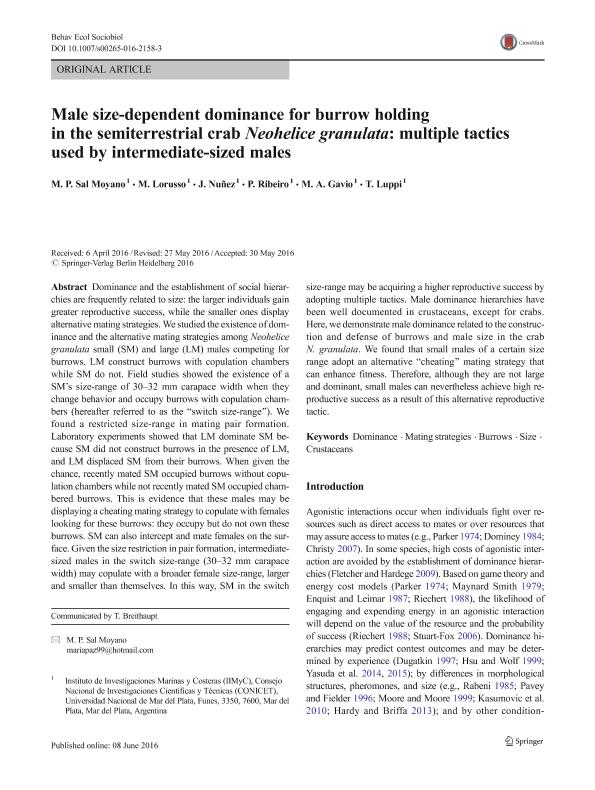Mostrar el registro sencillo del ítem
dc.contributor.author
Sal Moyano, María Paz

dc.contributor.author
Lorusso, M.
dc.contributor.author
Nuñez, Jesus Dario

dc.contributor.author
Ribeiro, Pablo Damián

dc.contributor.author
Gavio, Maria Andrea

dc.contributor.author
Luppi, Tomas Atilio

dc.date.available
2018-11-06T15:29:22Z
dc.date.issued
2016-09-08
dc.identifier.citation
Sal Moyano, María Paz; Lorusso, M.; Nuñez, Jesus Dario; Ribeiro, Pablo Damián; Gavio, Maria Andrea; et al.; Male size-dependent dominance for burrow holding in the semiterrestrial crab Neohelice granulata: multiple tactics used by intermediate-sized males; Springer; Behavioral Ecology And Sociobiology; 70; 9; 8-9-2016; 1497-1505
dc.identifier.issn
0340-5443
dc.identifier.uri
http://hdl.handle.net/11336/63741
dc.description.abstract
Dominance and the establishment of social hierarchies are frequently related to size: the larger individuals gain greater reproductive success, while the smaller ones display alternative mating strategies. We studied the existence of dominance and the alternative mating strategies among Neohelice granulata small (SM) and large (LM) males competing for burrows. LM construct burrows with copulation chambers while SM do not. Field studies showed the existence of a SM’s size-range of 30–32 mm carapace width when they change behavior and occupy burrows with copulation chambers (hereafter referred to as the “switch size-range”). We found a restricted size-range in mating pair formation. Laboratory experiments showed that LM dominate SM because SM did not construct burrows in the presence of LM, and LM displaced SM from their burrows. When given the chance, recently mated SM occupied burrows without copulation chambers while not recently mated SM occupied chambered burrows. This is evidence that these males may be displaying a cheating mating strategy to copulate with females looking for these burrows: they occupy but do not own these burrows. SM can also intercept and mate females on the surface. Given the size restriction in pair formation, intermediate-sized males in the switch size-range (30–32 mm carapace width) may copulate with a broader female size-range, larger and smaller than themselves. In this way, SM in the switch size-range may be acquiring a higher reproductive success by adopting multiple tactics. Male dominance hierarchies have been well documented in crustaceans, except for crabs. Here, we demonstrate male dominance related to the construction and defense of burrows and male size in the crab N. granulata. We found that small males of a certain size range adopt an alternative “cheating” mating strategy that can enhance fitness. Therefore, although they are not large and dominant, small males can nevertheless achieve high reproductive success as a result of this alternative reproductive tactic.
dc.format
application/pdf
dc.language.iso
eng
dc.publisher
Springer

dc.rights
info:eu-repo/semantics/openAccess
dc.rights.uri
https://creativecommons.org/licenses/by-nc-sa/2.5/ar/
dc.subject
Burrows
dc.subject
Crustaceans
dc.subject
Dominance
dc.subject
Mating Strategies
dc.subject
Size
dc.subject.classification
Otras Ciencias Biológicas

dc.subject.classification
Ciencias Biológicas

dc.subject.classification
CIENCIAS NATURALES Y EXACTAS

dc.title
Male size-dependent dominance for burrow holding in the semiterrestrial crab Neohelice granulata: multiple tactics used by intermediate-sized males
dc.type
info:eu-repo/semantics/article
dc.type
info:ar-repo/semantics/artículo
dc.type
info:eu-repo/semantics/publishedVersion
dc.date.updated
2018-10-12T18:14:59Z
dc.journal.volume
70
dc.journal.number
9
dc.journal.pagination
1497-1505
dc.journal.pais
Alemania

dc.journal.ciudad
Berlin
dc.description.fil
Fil: Sal Moyano, María Paz. Consejo Nacional de Investigaciones Científicas y Técnicas. Centro Científico Tecnológico Conicet - Mar del Plata. Instituto de Investigaciones Marinas y Costeras. Universidad Nacional de Mar del Plata. Facultad de Ciencias Exactas y Naturales. Instituto de Investigaciones Marinas y Costeras; Argentina
dc.description.fil
Fil: Lorusso, M.. Consejo Nacional de Investigaciones Científicas y Técnicas. Centro Científico Tecnológico Conicet - Mar del Plata. Instituto de Investigaciones Marinas y Costeras. Universidad Nacional de Mar del Plata. Facultad de Ciencias Exactas y Naturales. Instituto de Investigaciones Marinas y Costeras; Argentina
dc.description.fil
Fil: Nuñez, Jesus Dario. Consejo Nacional de Investigaciones Científicas y Técnicas. Centro Científico Tecnológico Conicet - Mar del Plata. Instituto de Investigaciones Marinas y Costeras. Universidad Nacional de Mar del Plata. Facultad de Ciencias Exactas y Naturales. Instituto de Investigaciones Marinas y Costeras; Argentina
dc.description.fil
Fil: Ribeiro, Pablo Damián. Consejo Nacional de Investigaciones Científicas y Técnicas. Centro Científico Tecnológico Conicet - Mar del Plata. Instituto de Investigaciones Marinas y Costeras. Universidad Nacional de Mar del Plata. Facultad de Ciencias Exactas y Naturales. Instituto de Investigaciones Marinas y Costeras; Argentina
dc.description.fil
Fil: Gavio, Maria Andrea. Consejo Nacional de Investigaciones Científicas y Técnicas. Centro Científico Tecnológico Conicet - Mar del Plata. Instituto de Investigaciones Marinas y Costeras. Universidad Nacional de Mar del Plata. Facultad de Ciencias Exactas y Naturales. Instituto de Investigaciones Marinas y Costeras; Argentina
dc.description.fil
Fil: Luppi, Tomas Atilio. Consejo Nacional de Investigaciones Científicas y Técnicas. Centro Científico Tecnológico Conicet - Mar del Plata. Instituto de Investigaciones Marinas y Costeras. Universidad Nacional de Mar del Plata. Facultad de Ciencias Exactas y Naturales. Instituto de Investigaciones Marinas y Costeras; Argentina
dc.journal.title
Behavioral Ecology And Sociobiology

dc.relation.alternativeid
info:eu-repo/semantics/altIdentifier/doi/https://dx.doi.org/10.1007/s00265-016-2158-3
dc.relation.alternativeid
info:eu-repo/semantics/altIdentifier/url/https://link.springer.com/article/10.1007/s00265-016-2158-3
Archivos asociados
